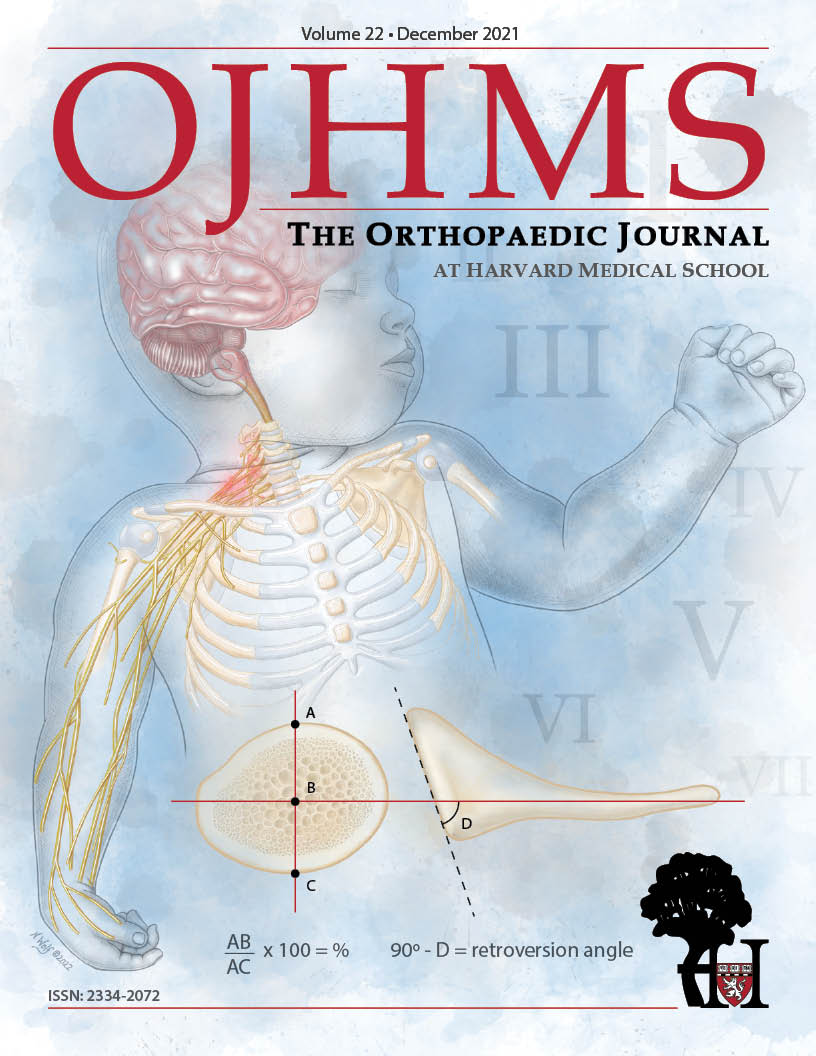Biomechanical Comparison of Arthroscopic SMC Knot Constructs
Ryan A. Hoffman MD, Mustfa K. Manzur MPH, MS, Michael V. Narvaez, MD, Robert K. Merrill MD, Colin M. Whitaker MD, Brett A. Sweitzer MD
©2021 by The Orthopaedic Journal at Harvard Medical School
BACKGROUND The Samsung Medical Center (SMC) knot is commonly utilized in arthroscopic orthopedic surgery. It is unclear if SMC knot constructs including four reversing half-hitches (RHH) can be utilized to achieve an overall secure knot construct.
METHODS One fellowship trained orthopedic surgeon tied 70 SMC knots. Each knot was reinforced with either:
- four RHH with the knot flipped outside the cannula between each throw
- four RHH with the knot flipped inside the cannula between each throw
- four RHH without flipping on alternating posts (RHAP)
- two RHH, followed by flipping the knot outside the cannula, then two additional RHH
- two RHH, followed by flipping knot inside the cannula, then two additional RHH
RESULTS The average force required to displace the loop 3mm was maximized when knot flipping was not performed (252N±48N) and minimized when a single flip was performed inside the cannula (206N±53N). The average force that caused loop failure was greatest when multiple flips were performed inside the cannula (328N±42N) and least when a single flip was performed inside the cannula (294N±62N). There was no difference in average force causing loop displacement ≥3mm (P=0.13) or loop failure (P=0.41).
CONCLUSION SMC knots paired with four RHH to reinforce the initial sliding self-locking knot, regardless of knot flipping intra- versus extra-articular, or knot flipping all-together, enable a consistently secure overall knot construct.
LEVEL OF EVIDENCE Level V Bench Testing
KEYWORDS Arthroscopic; knot tying; SMC knot; intra-articular; extra-articular; reverse half-hitches
Arthroscopic knot tying is an essential tool for the orthopedic surgeon when repairing rotatorcuff tears, Bankart lesions, and similar soft tissue injuries. While a vast amount of data exists pertaining to methods of knot tying, many questions still require further exploration. A surgeon must consider varying knot styles, reinforcement techniques, and suture types when operating to maximize the utility of each knot tied.
Knot holding capacity (KHC) is a characteristic which often influences which knot and suture material to use. KHC is measured using two metrics: knot security and loop security. Knot security is the resistance of slippage or deformity with application of a load. Failure of a knot is typically recognized when a given knot has slipped ≥3mm.1 Loop security is the ability for a loop to remain taut after an initial knot has been placed. Due to the potential for slack to occur in a loop while each knot remains intact, it is possible to have knot security with poor loop security.1,2 These critical aspects help a surgeon identify which knots are most likely to be successful in vivo. Furthermore, current literature suggests that flipping knots, either by switching the knot pusher from one strand to another, or with alternating strand tension (pulling tighter on one strand than the other) can act as an adjunct to maximize knot security by preventing slippage.2
Arthroscopic surgeons should be comfortable tying both a static and sliding knot, as well as working with a number of different sutures. Researchers at Samsung Medical Center (Seoul, South Korea) developed the eponymous SMC knot. This knot has increased in popularity given its demonstrated ability to reliably lock sliding knots in arthroscopic repairs while providing adequate loop security.2,3 Recently, it has been shown that supplementation with three reversing half-hitches on alternating posts (RHAP) maximizes knot holding capacity within SMC knot constructs.2,3,5 Adding RHAP not only improves knot security, but converts mechanism of failure from slippage to suture failure, thus improving overall KHC. The traditional technique of switching the knot pusher from one strand to another in order to alternate posts can add significant time to the surgical procedure, thus Burkhart et al. described an approach for switching posts without need for rethreading when tying half-hitches.6,7 With the Burkhart et al. technique, knots are flipped intra-articularly at the knot construct. However, this shortcut may introduce undesirable stress on the knot, potentially reducing knot security. Thus, another technique, involving alternating strand tension outside of the cannula prior to pushing the half hitch down to the knot may be preferable, as knot flipping is conducted in an extra-articular fashion.
Current literature lacks investigation into potential detrimental effects related to intra-articular knot flipping on knot security. Similarly, work determining the optimum location to flip the half-hitch, either inside or outside the joint, has not been reported. Typically, surgeons tie an initial sliding knot, followed by reversing half-hitches (over, then under) with subsequent flipping of the knot inside the cannula (at the sliding knot) by pulling on the wrapping strand-all of which is then secured with additional reversing half-hitches. Theoretically, pulling on the wrapping strand places stress on the initial knot, potentially causing disruption. In this study, the traditional flipping method was compared with a novel technique of flipping the knot outside of the cannula, immediately prior to pushing the half-hitch down to an initial SMC knot.
The aim of this study was to determine if different reinforcing constructs over an SMC knot would affect KHC. Further, formal exploration regarding identification of the relative number of flips necessary for ideal KHC was conducted. A priori, it was hypothesized that the SMC knot’s self-locking mechanism enables consistent KHC as well as clinical and maximum measures of load failure. It was also hypothesized that the SMC knot does not vary in performance, regardless of the supplementary knot construct reinforcement approach.7,8
SMC knots were tied around a 30mm circumference rod using a single-lumen knot pusher. Each SMC knot was reinforced with stacked reversing half-hitches using one of the following five techniques:
- four RHH with the knot flipped outside the cannula between each throw Figure 1
- four RHH with the knot flipped inside the cannula between each throw Figure 2
- four RHH without flipping on alternating posts (RHAP)
- two RHH, followed by flipping the knot outside the cannula, then two additional RHH
- two RHH, followed by flipping the knot inside the cannula, then two additional RHH
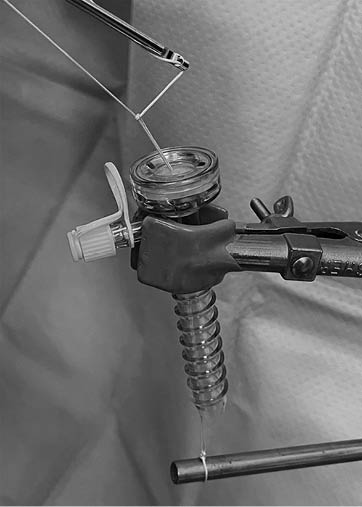
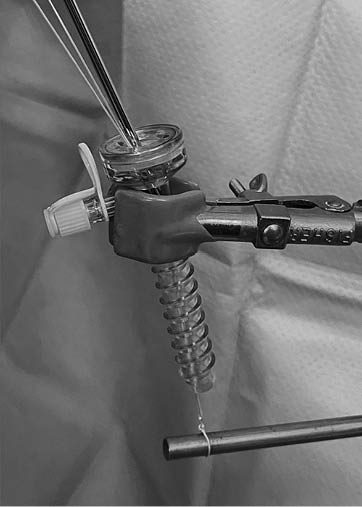
The following technique was utilized for knot-flipping:
- tension released on the post
- gentle traction applied to the wrapping limb at the same time in opposite directions, thus flipping the knot
- subsequent reversing half-hitches thrown
An example of the intra-articular technique would be the following:
- SMC knot pushed down
- overhand throw pushed down
- underhand throw pushed down
- flipping the knot intra-articularly by simultaneously releasing tension on the post and pulling tension on the wrapping strand
- overhand throw pushed down
- underhand throw pushed down
In contrast to the intra-articular technique, extra-articular flipping of the post was alternated in a similar manner outside the cannula prior to advancing the throw. This was done by:
- releasing tension on the post limb, while moving it forward, ahead of the half-hitch
- at the same time, gentle traction was applied to the wrapping limb in the opposite direction, prior to using the half-hitch downwards along the cannula towards the knot6,8,9
An example of such a technique would be the following:
- SMC knot pushed down
- overhand throw pushed down
- underhand throw pushed down
- overhand throw
- flipping the knot outside the cannula prior to pushing the throw down the cannula to the knot
- complete with a final underhand throw pushed down
A total of 14 loops were tied for each of the five knot categories. All knots were tied by a sports medicine fellowship trained orthopedic surgeon (BAS) proficient in arthroscopic knot tying technique. Braided non-absorbable suture, No. 2 Ultrabraid™ (Smith & Nephew Inc., Andover, MA, USA), was utilized to create each construct. Such braided non-absorbable suture products have previously demonstrated consistently higher load to failure capacity than available alternative products.10-13 The knots were tied either outside or inside of an arthroscopic cannula to attempt to recreate an operative environment where extra-cannula can be analogous to extra-articular. Once tied, each set of knots was soaked in saline and kept at normal body temperature (37.0 degrees Celsius) for seven days to simulate native conditions in the joint during arthroscopy.
A materials testing system (MTS, TestResources Inc., Shakopee, Minnesota, USA) paired with a digital load sensor (Loadstar Sensors, Fremont, California, USA) was utilized to test the knot and loop security of each knot type in an approach originally described by Lo et al.1 Specifically, a vertical rod was mounted on both actuator and base of the MTS. Next, each loop was placed around each rod. Crosshead displacement with a 5N preload was applied. Subsequently, loop security was measured to ensure every knot was tied with consistent tension. Each suture loop was then loaded to failure, at a speed of 1mm/s, in order to test knot security. Clinical failure was recorded at a knot displacement of ≥3mm, resulting in a larger loop. Maximum failure was recorded as the maximum recorded value from each load to failure cycle Figure 3. Additionally, the circumference of each loop was calculated according to the following formula:
- 2 x cross-head displacement + 4 x rod radius + rod circumference1
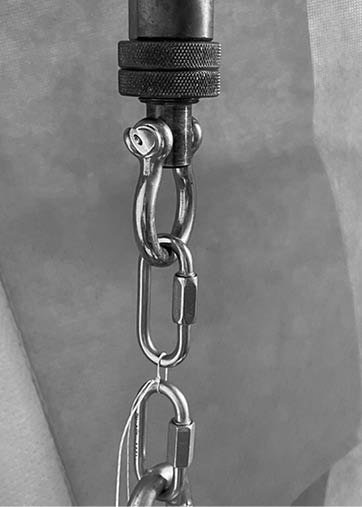
Cyclic testing was not conducted in this study because existing work by Kelly et al. suggested that four half-hitches significantly minimized peak elongation on cyclic testing and maximized knot security with similar braided non-absorbable suture products.10
All data was analyzed using R Version 3.3.3 (R Foundation for Statistical Computing, Vienna, Austria). The two outcome variables tested among knot types were the average force required to displace the loop ≥3mm and the average force required to bring the loop to failure. Outcome variables were continuous and reported as means ± standard deviation with length measurements to the nearest hundredth digit and forces rounded to the nearest Newton. Comparisons of these continuous variables was performed with a one-way analysis of variance (ANOVA) followed up with confirmatory post-hoc Tukey’s Honest Significant Difference testing. Statistical significance was assigned at the <0.05 P value threshold.
Fourteen loops were tied for each of the five knot categories, leading to an examination of 70 knots’ performance. The average force required to displace the loop 3mm was highest when knot flipping was not performed (252N±48N) and was lowest when a single flip was performed inside the cannula (206N±53N) (Table 1, Figure 4). Variability in the measurement of force required to displace the loop ≥3mm was observed when a single flip was performed inside the cannula. In contrast, variability in the measurement of force required to displace the loop ≥3mm was minimized when multiple flips were performed outside the cannula. There was no statistically significant difference in the average force required to displace the loop ≥3mm between the different knot types (P=0.13), suggesting overall lack of difference in knot security across all constructs examined.
Comparison of intra- versus extra-cannula knot flipping techniques revealed no significant difference in both knot and loop security. Average load to failure for groups one through five were 219N±39N, 220N±49N, 252N±48N, 226N±48N, and 206N±53N, respectively (Table 1, Figure 4). The average force that caused a loop to fail was highest when multiple flips were performed inside the cannula (328N±42N), and lowest when a single flip was performed inside the cannula (294N±62N) (Table 1, Figure 5). The highest variability in force was also seen when a single flip was performed inside the cannula. No statistically significant difference was observed between the different knot types with respect to the average force that caused failure of the loop (p = 0.41). Additionally, the average change in diameter of the loops among the five groups were:
- 29.53 ± 0.32mm
- 29.89 ± 0.31mm
- 29.11 ± 0.27mm
- 29.75 ± 0.40mm
- 29.47 ± 0.38mm

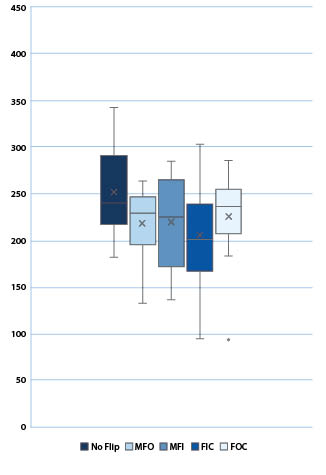
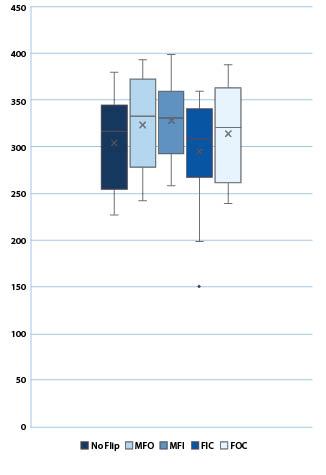
Though the group with a single intra-articular flip had the lowest load to failure of loop or knot security, there was no statistically significant difference in loop or knot security between the examined knot construct groups (P>0.05).
Arthroscopic knot tying is a valuable method for securing soft tissue during surgical repairs. In choosing optimal fixation, one must investigate different knot styles as well as suture compositions. When deciding which type of knot to select, one must choose between sliding and non-sliding knots. In most instances, sliding knots are preferred when the correct environment facilitates this decision. In general, both strands must be able to move easily through the tissue in order to allow use of sliding knots. If there is any hindrance, a non-sliding knot is preferred. In this study, the SMC knot was chosen in part for the senior surgeon’s familiarity with the knot, but also for its self-locking ability and loop security. Sufficient knot security is defined as preventing 3mm of slippage of the knot,1 thus maintaining adequate fixation and preserving KHC. Beyond this distance, appropriate tissue fixation generally cannot be achieved.1-2,5-7 As reported by Kim et al., the SMC knot provides good knot and loop security. In this previous study, it was found that three additional RHAP thrown behind the SMC knot helped to optimize KHC. In our study, an additional fourth RHAP was tied to realize previously demonstrated benefits of minimized peak elongation and maximized knot security.2,10
In this study, we attempted to investigate if flipping knots inside or outside an arthroscopic cannula (representative of the joint) would demonstrate any difference with KHC. Previous knot constructs described in the literature involve throwing an initial sliding knot inside the cannula, supplementing with thrown reversing half-hitches, flipping the knot, and then completing the knot with additional half-hitches. With this method, one pulls on the knot to facilitate a flipping motion. The authors of this paper believed that this approach may potentially weaken the knot, resulting in compromised knot security. Thus, an alternate technique was developed, in which the knot is flipped outside of the cannula, prior to sending the half-hitch down to the knot. We believed this would be less intrusive on the knot and examined this approach by adjusting the number of knot flips. Despite our understanding of introducing potential knot disruption, the data in the current study does not suggest a significant difference associated with where a knot is tied nor the number of times it is flipped.
Previous studies have shown that addition of several RHH can transform the mode of failure from knot slippage to suture elongation/breakage. Lo et al. investigated this method by adding sequentially more force on suture loops containing sliding knots with and without addition of RHAP.1 In their study, the addition of at least three RHAP led to diminished knot slippage and increased suture elongation. While breakage was not appreciated, the investigators suggested that continued force increases would have yielded breakage. Livermore et al. reported similar findings, thereby further influencing the decision to use multiple RHH in this study.14 Furthermore, our findings paralleled this finding to a degree. In all tested groups, it was found that the force at which KHC was disrupted 3mm was less than the maximal force to failure. Suture elongation was indeed the method by which failure was observed in this work, thereby justifying use of at least three RHH for decreased failure by knot slippage.1
Data yielded in the current work suggest no significant difference in KHC, regardless of where knots are flipped or the number of flips included in the supplementary knot construct. Concern that flipping reverse half hitches outside of the cannula may decrease stress on the knot was not supported. Furthermore, while previous studies have demonstrated that RHAP help to improve KHC, this study suggests that knot flipping is not essential for improving knot security. The superiority of the SMC knot relative to other sliding knots may be associated with provision of superior initial knot security. Specifically, the SMC knot is designed with a self-locking mechanism which may render additional flipping or location of tying insignificant so long as the knot itself is positioned against the tissue and secured appropriately. Further research is necessary to examine the downstream impact on KHC associated with various initial sliding knot constructs (e.g. SMC knot versus Weston, Taut-line, etc.) when knot flipping and number of knot flips are adjusted.
Several limitations were observed in this study. First, only one knot tyer and one type of sliding knot was utilized. Furthermore, as previously described, the knot chosen is one of superior locking ability without flipping or reverse hitches. The results of this study could have been more generalizable had this knot been compared across multiple surgeons as well as with other commonly utilized knots such as the Duncan, Tennessee, Weston, Taut-line, and others. Second, while more previously reported data supports three RHH being sufficient to optimize KHC with the SMC knot, this study utilized four RHH. It is possible that the fourth RHH was redundant, and the results reported herein may only apply to SMC knots supplemented with four RHH. Finally, braided non-absorbable suture, No. 2 Ultrabraid™ (Smith & Nephew Inc., Andover, MA, USA), was utilized to create each construct. This initial exploration of SMC knot optimization focused on a braided non-absorbable suture material, particularly No. 2 Ultrabraid™, because this product provides the highest load to failure along with comparable loop and knot security among all commonly utilized braided polyblend sutures commonly implemented in arthroscopic procedure knot constructs within the domain of orthopedic surgery.10,11,15 While this suture is commonly utilized in arthroscopic orthopedic surgery procedures, comparison with generic monofilament or other multifilament braided non-absorbable suture products would have provided additional opportunity for examining various knot iterations’ performance across materials. Specifically, it is possible that alternative sutures would have demonstrated differential performance in loop displacement and/or failure potentially related to material-specific internal friction force dynamics.15 Cyclic load testing was also not conducted given the existing work that has explored this issue.10 Additionally, without insight into potential effect size, a power analysis was not conducted.
SMC knots tied with braided suture paired with four RHH to reinforce the initial sliding self-locking knot, regardless of knot flipping intra- versus extra-articular, or knot flipping all-together, enable a consistently secure overall knot construct. Further research to explore the impact of materials variance for optimizing performance of the SMC knot is imperative.
The majority of postoperative rehabilitation for BT is lacking consensus. This study highlights the variability of clinical recommendations among online available BT rehabilitation protocols. Gaps in the literature have been presented, allowing for future impactful research studies and the development of evidence-based guidelines for BT rehabilitation.

